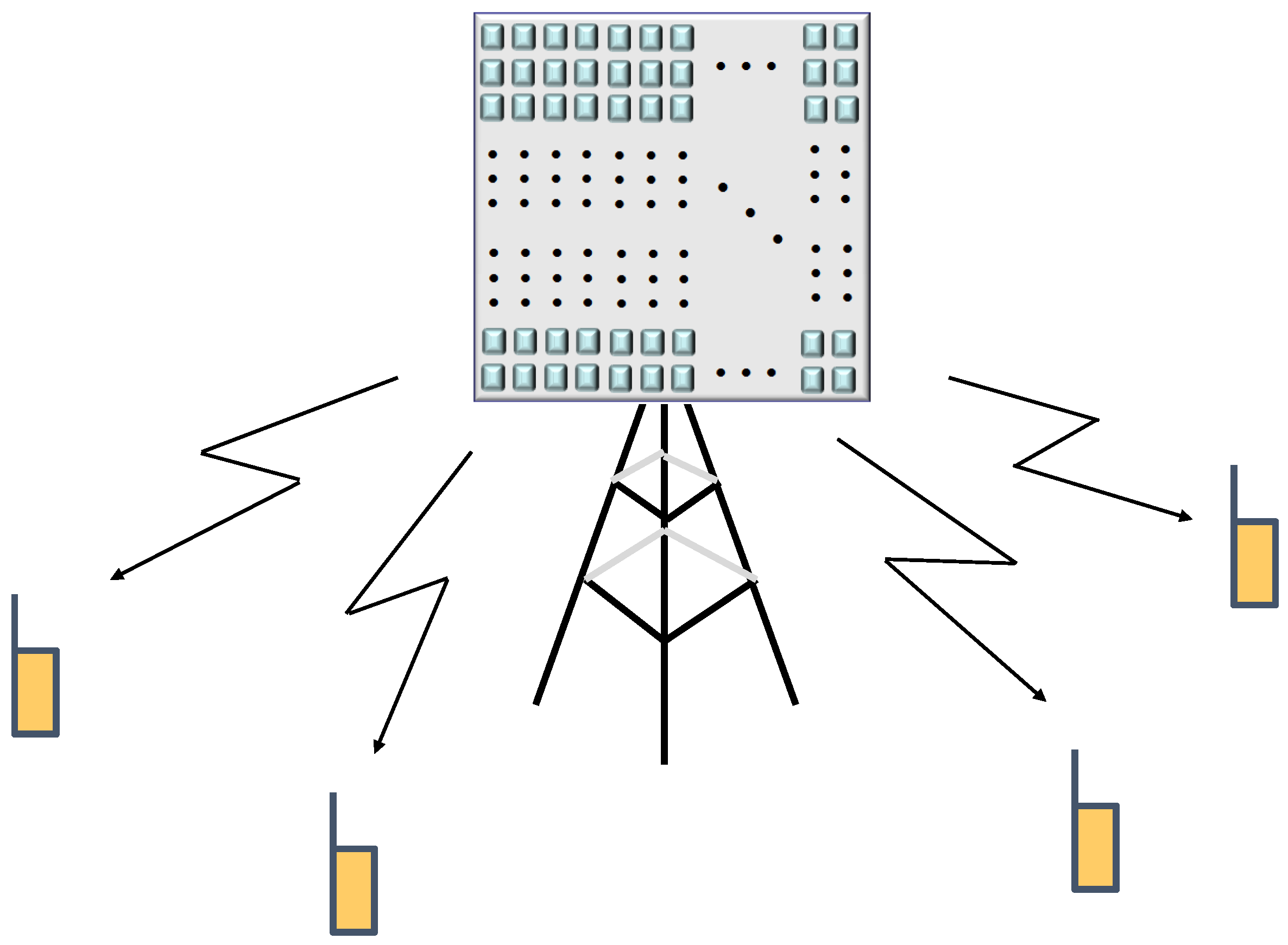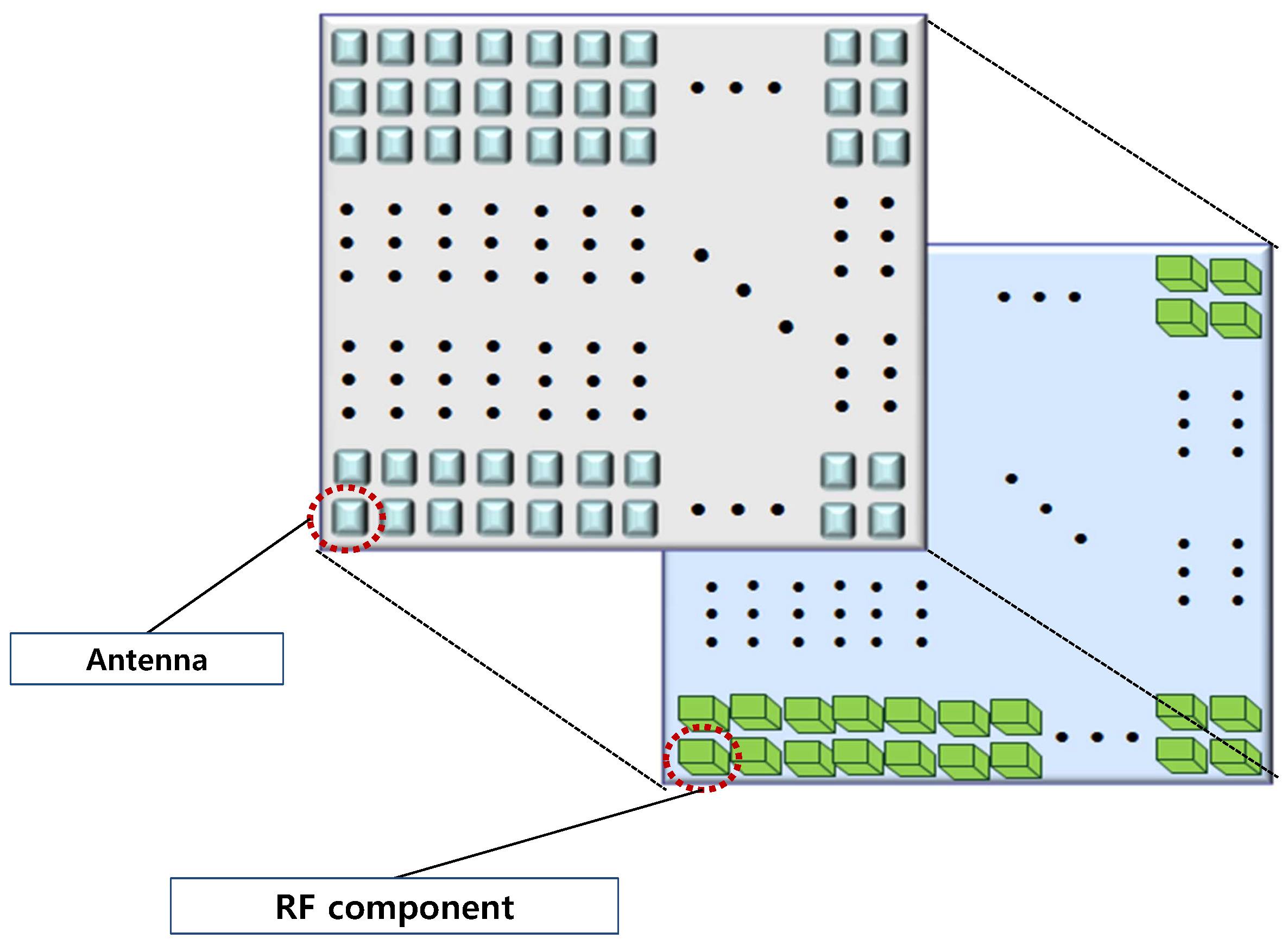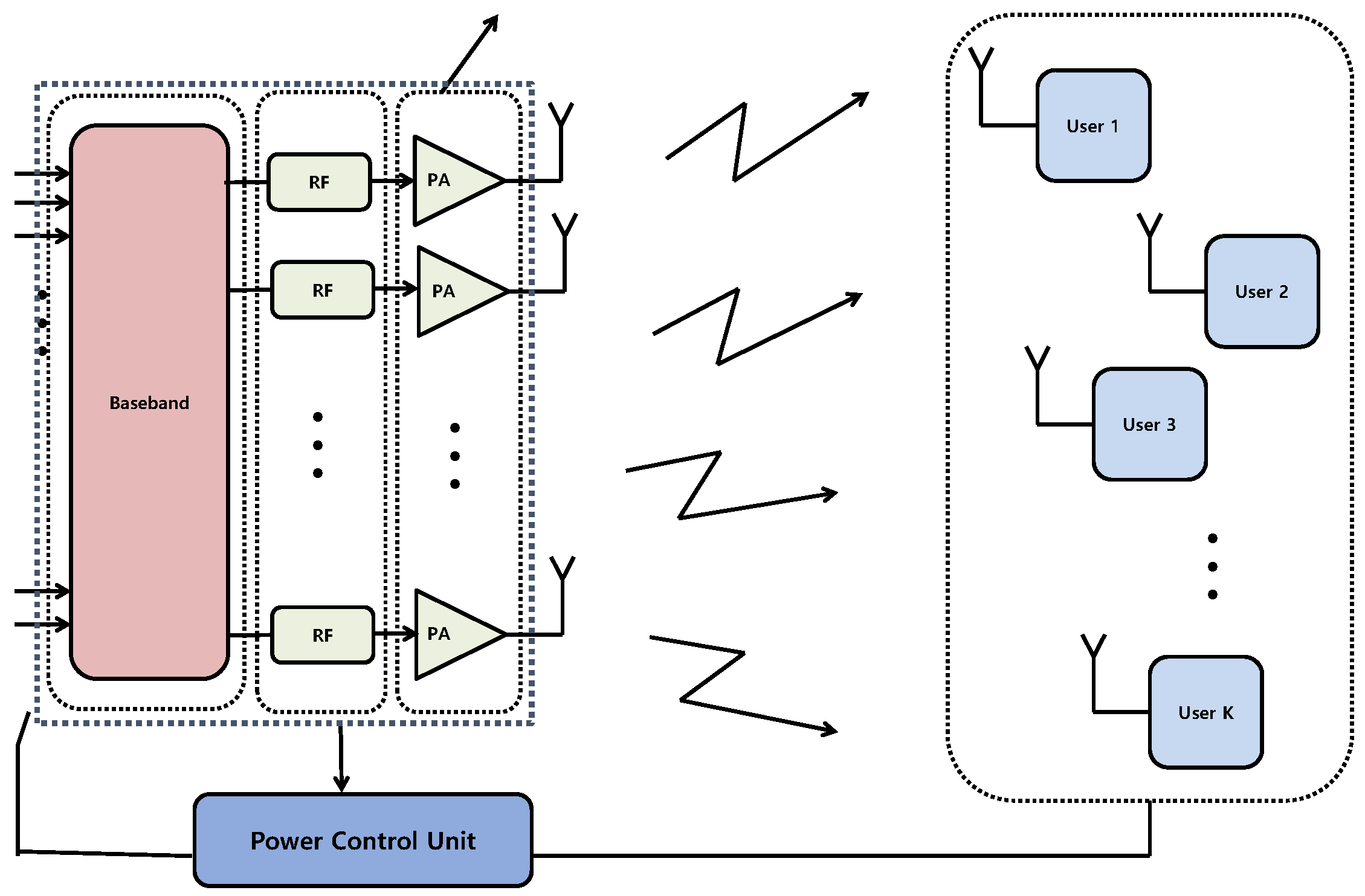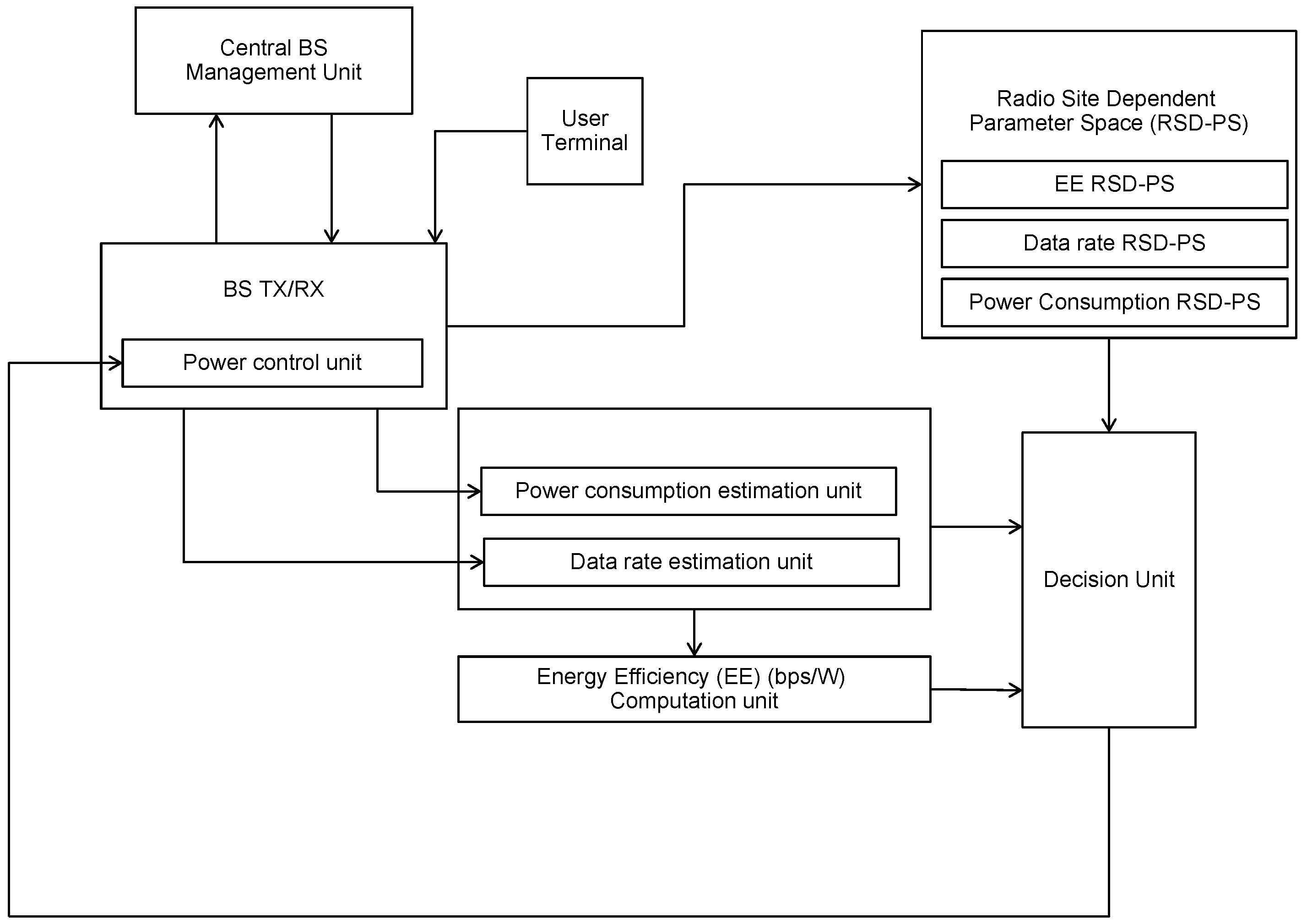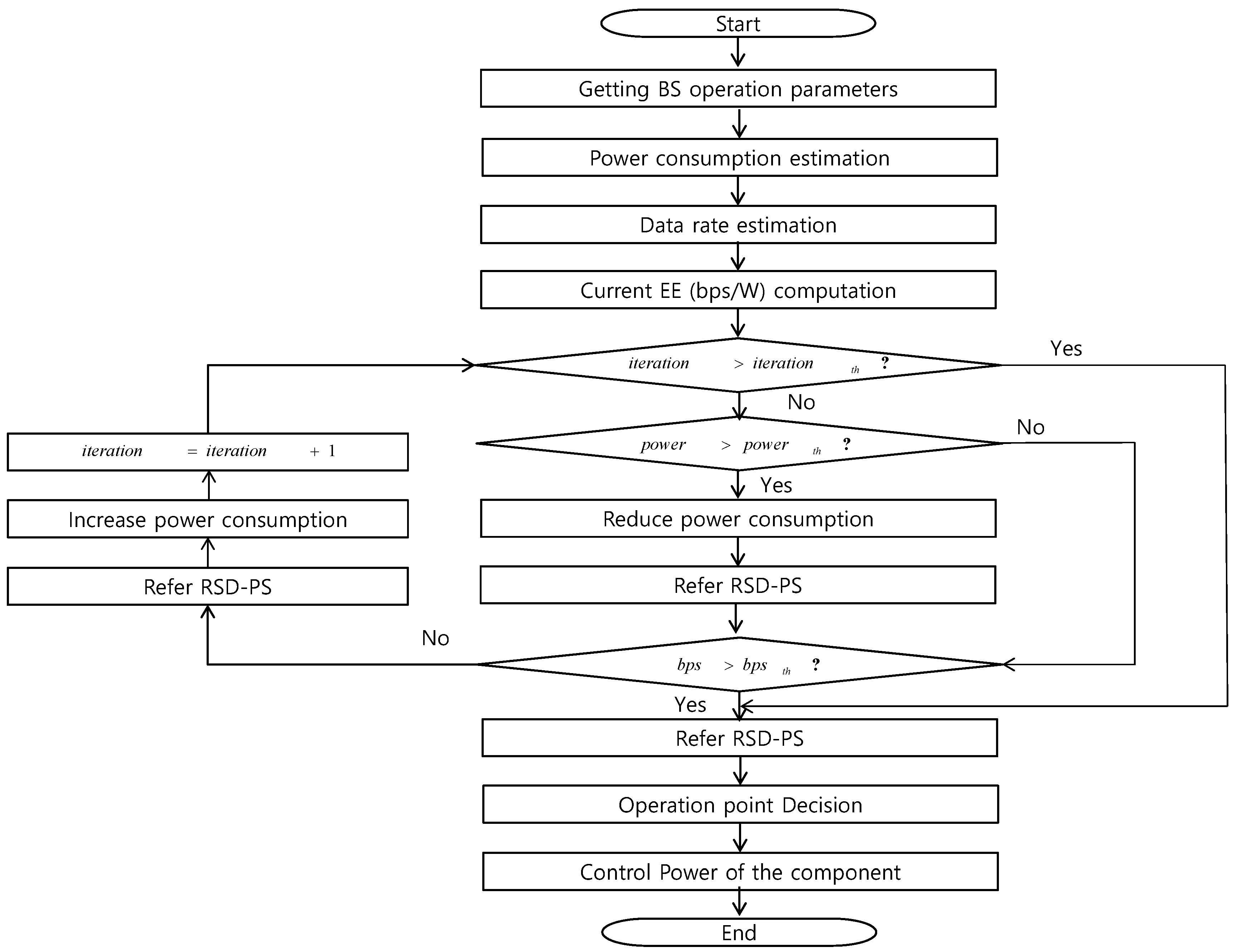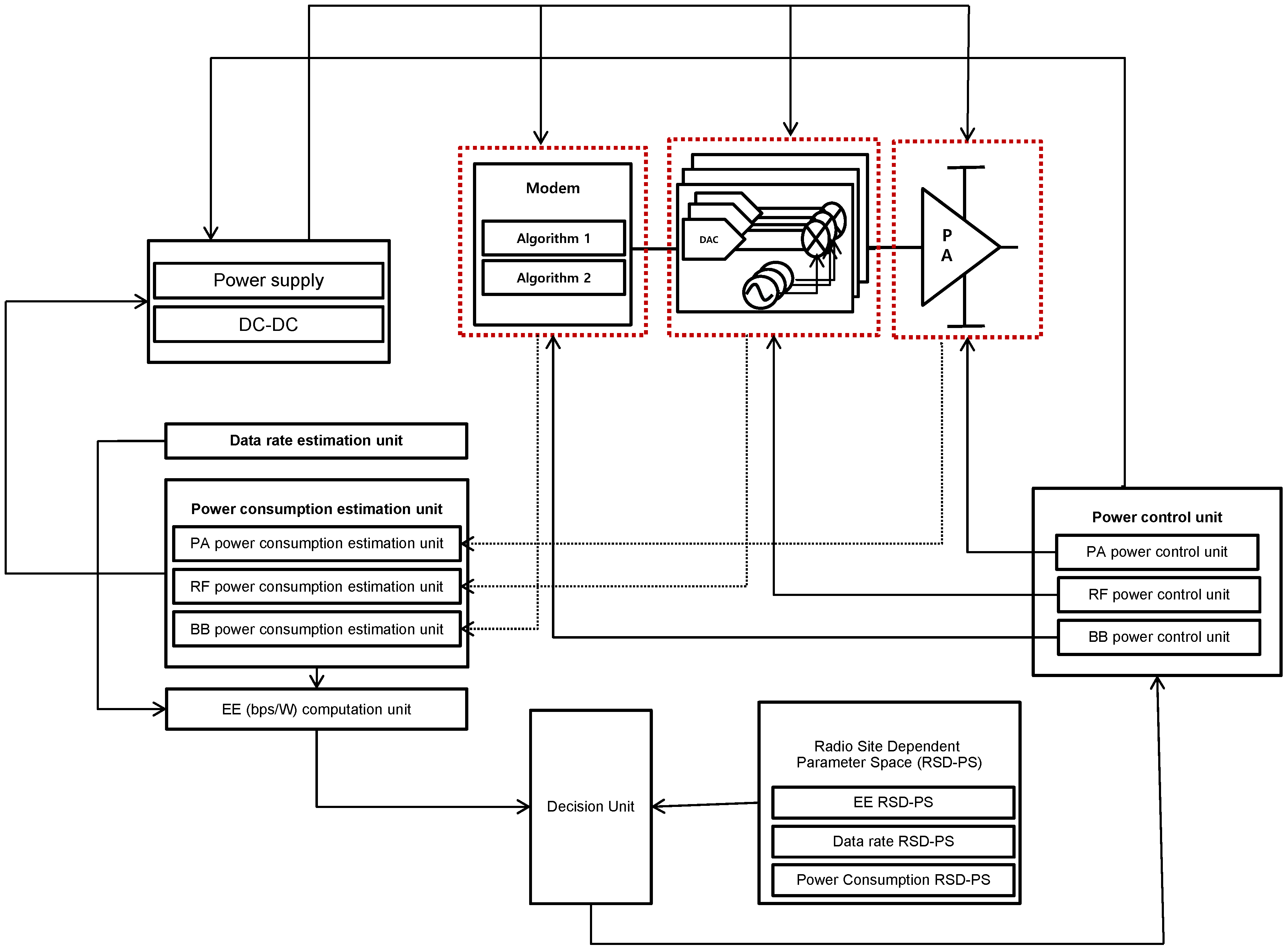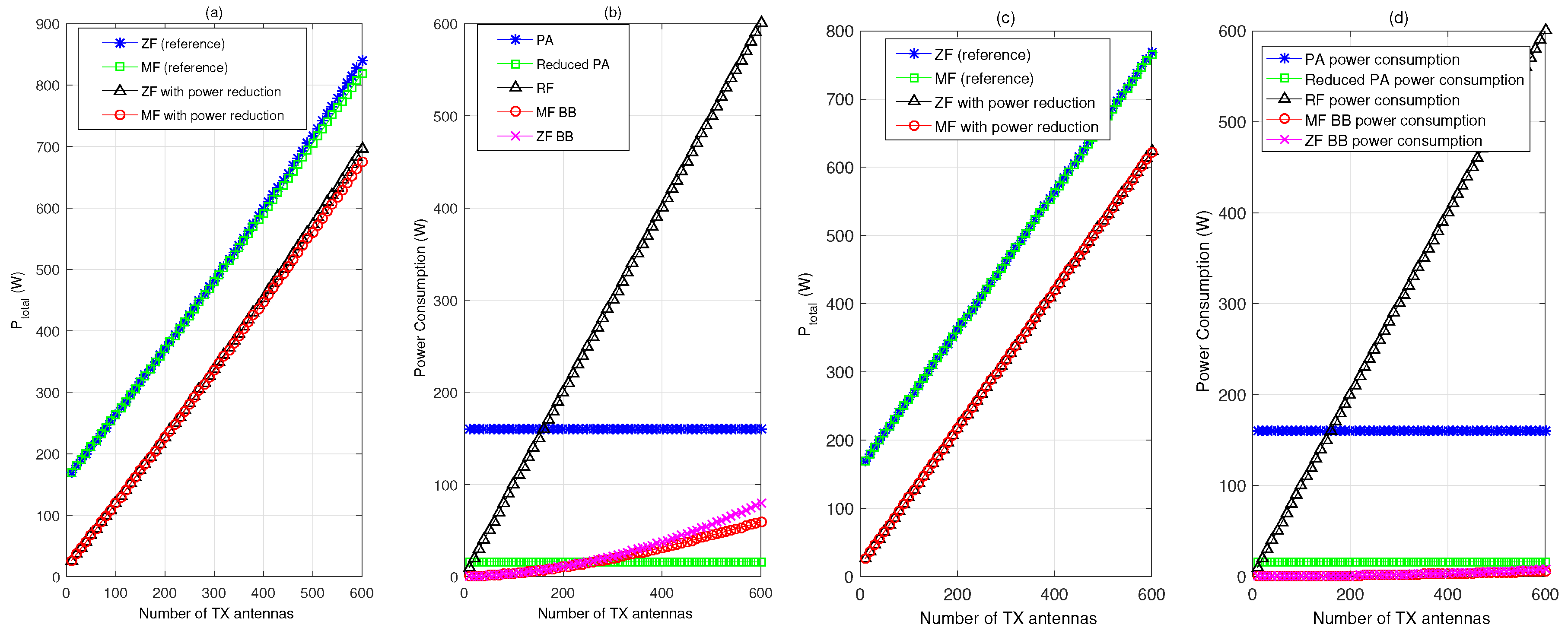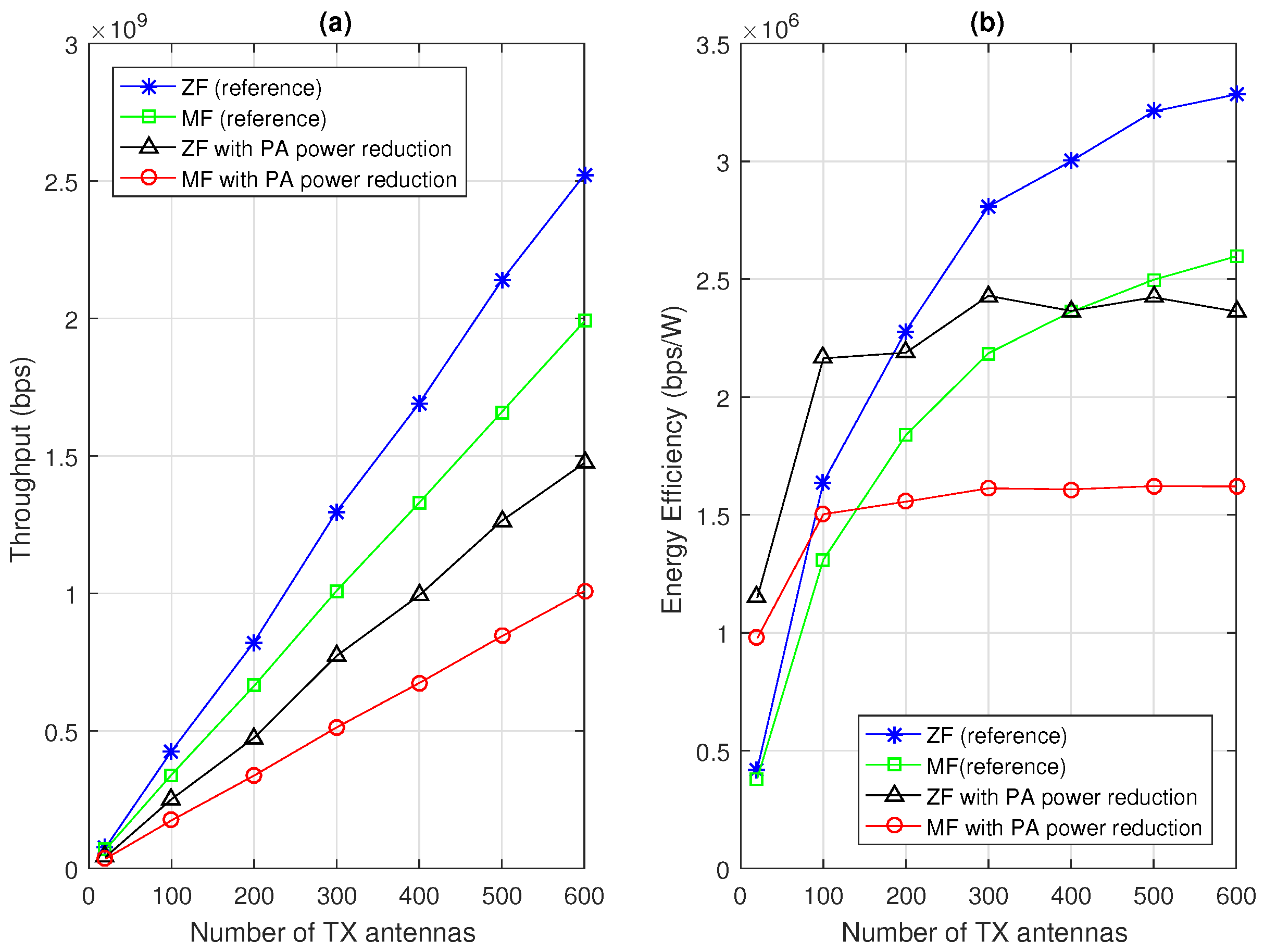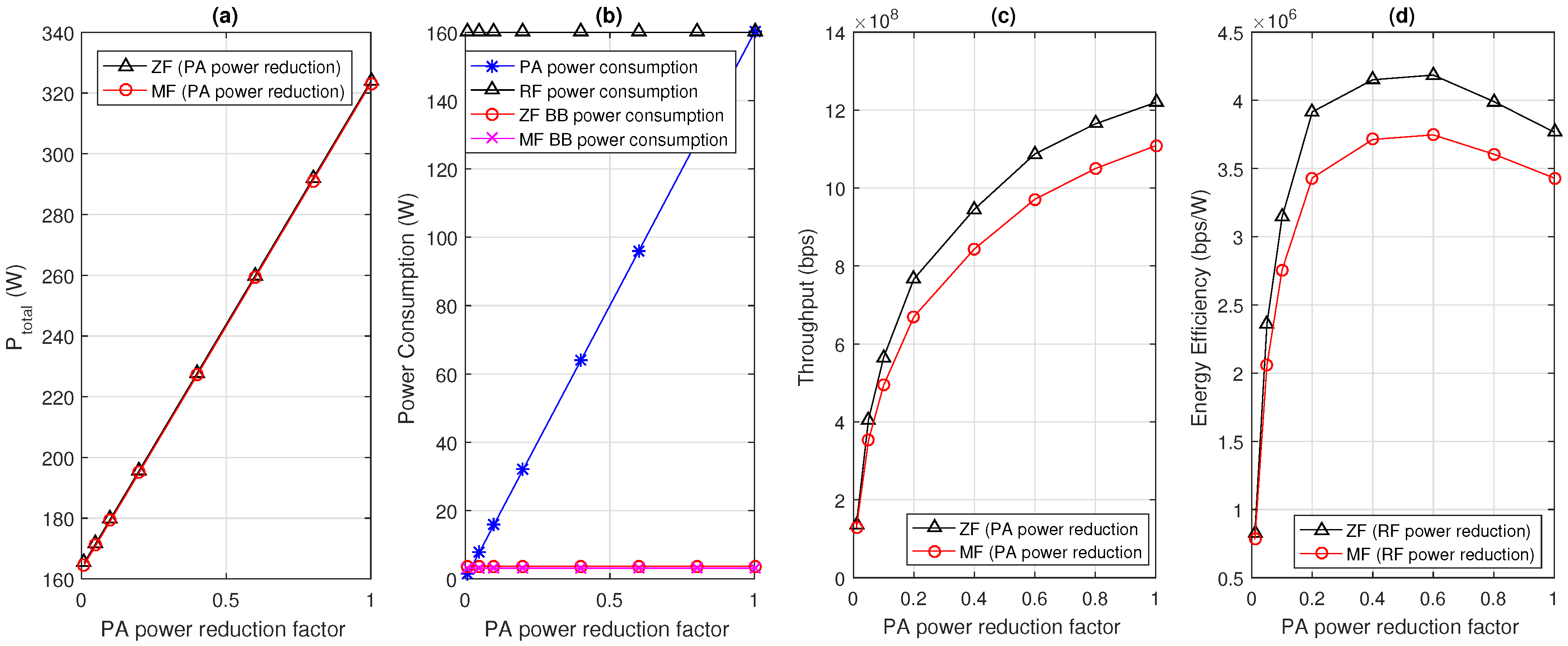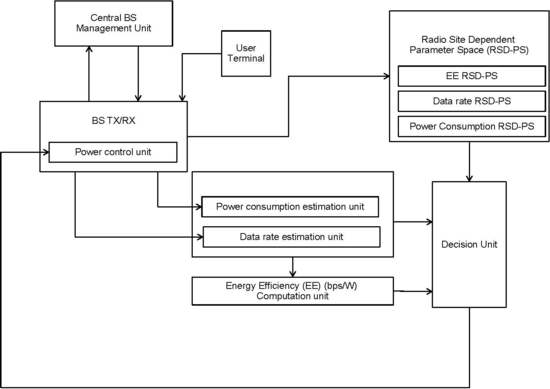1. Introduction
Communication technologies that can increase channel capacity, as well as energy efficiency (EE) would be a key factor for future wireless systems. An increase in EE is very important because the continuous increase in data demanded by end-users results in a high cost both from an environmental and technological perspective. It is well known that base stations (BS) consume around 60%–80% of power consumption in cellular networks [
1,
2,
3]. Thus, reducing the power consumption of a BS is quite important to reduce the operational costs, as well as the carbon footprint. For this reason, researchers have actively investigated this problem [
1,
2,
4,
5,
6,
7,
8,
9,
10,
11,
12,
13,
14,
15]. Most work has concentrated on implementing the BS on/off technique, which means that the BS is turned off when there is no nearby traffic [
1,
2,
9,
10,
12,
14], as well as on conducting theoretical high-level analyses and optimizations to reduce the BS power consumption [
7,
8,
11,
13]. However, the BS on/off technique is only beneficial for an empty network, which rarely happens in actual networks. Furthermore, there could be many real implementation obstacles for theoretical, high-level optimization techniques.
In this paper, rather than presenting a BS on/off mechanism or solving the theoretical optimization problem, we focus on more practical implementation aspects to improve the EE of cellular systems. We propose a future energy-efficient BS structure and its related operation using a realistic power model for real implementation. Due to the limited spectrum resources, it is also inevitable for the number of transmitter (TX) antennas in the BS to continuously increase [
11]. Thus, we assume that a future BS has a large number of TX antennas, that is a large-scale (LS) antenna system or LS multiple-input multiple-output (MIMO) [
16,
17,
18]. Actually, in the case of a BS with LS-MIMO, the resource allocation problems are easier to solve if the channel properties provided by LS-MIMO systems are exploited smartly [
19,
20].
The proposed energy-efficient BS consists of five main components: a central management apparatus, power controller, EE calculator, radio site-dependent parameter space (RSD-PS) and determiner. The central management apparatus manages the appropriate power consumption of each BS located in a pre-defined range. The power controller controls the power control of each related device. The EE calculator, which operates based on the power consumption and data rate estimator, provides the power control metric. The RSD-PS accumulates information and supports the increase in EE according to past operation information. The determiner for each decision unit decides the operation points of the power-related devices for a pre-defined time duration. Each component can also be divided into several sub-components. With these components, we show how to systematically increase the EE of the proposed future BS. The BS could also be used as a hub for a LS sensor system for a smart city or such.
In what follows, we introduce the system model in
Section 2. In
Section 3, we present the proposed BS structure and the method used to systematically increase the EE of the BS. In
Section 4, we present numerical results based on a reference future BS model, showing the effectiveness of the proposed structure and method. Finally, the conclusions are drawn in
Section 5.
3. Energy-Efficient BS Structure and Related Operation
To achieve a high EE for the BS, it is essential to control some of the important TX parameters there. We can divide the main BS power consumption components in PA, RF (except PA) and BB and make out each component to be a power-adjusting component. The PA is the most power-hungry device in the current BS, but this could change depending on the situation of a future BS. Since a future BS could have a large amount of RF chains connected to each antenna, it is also possible for the RF chain to consume more power than the PA. In contrast to the PA, which can reduce the power consumption by using a beamforming effect, there are no distinct sources to reduce the RF chain power consumption. The BB may consume less power when compared to the PA and RF. However, it is better to include it as one of the adjustable parameters to enhance the EE. The three main components can be controlled as shown in
Figure 4.
An energy-efficient future BS is quite obviously a feedback system. It mainly receives information of the power consumption from the BS TX unit and information regarding the data rate from the user terminals. As shown in the figure, the power control unit controls each component based on the measured EE parameters. The proposed BS measures the data rate, and if it is not in a satisfactory range, it provides an input to power the adjustable unit to increase the power consumption of some of the components. Then, based on the power adjustment of each component, the data rate estimation unit measures the data rate again and checks if it is in the satisfactory range, and so on. If the power consumption is too high over a pre-defined threshold, then the data rate could also be reduced to obtain satisfactory EE performance.
Based on the high-level concept of a future BS, the detailed block diagram of the proposed BS structure is described in
Figure 5.
First, let us observe two units, the power consumption estimation unit and the data rate estimation unit, which are tightly connected with the fundamental TX/RXunit of the BS. The BS provides information for the units based on feedback from self-measurement and user terminals, then EE (bps/W) can be derived based on the results. All information (power consumption, data rate, EE) is given to the decision unit, which can then decide each component’s power consumption, i.e., PA, RF and BB. The decision unit provides feedback on the decision to the fundamental TX/RX unit of the BS. Then, the BS performs power control based on the feedback information.
There are three more components in this structure, as shown in the figure. The first one is the central BS management unit. This apparatus can be used for multi-BS power control/optimization. The central BS management unit monitors all nearby BSs and adaptively allocates the allowable maximum power for each BS. Then, each BS only allocates power for each component based on the total allowable power consumption criterion. The second one is the user terminal. In particular, the data rate can be easily measured with a user terminal. Furthermore, it is beneficial for the user terminal to give feedback regarding the current channel condition. The last one is the RSD-SP. The RSD-SP is the apparatus that accumulates the history of optimum BS operation, and supports the decision unit to determine the operating points of BS based on the accumulated history whenever necessary. For example, RSD-PS monitors the BS operation, such as the level of radiation power, the level of the resolution of the RF chain, the level of BB processing based on operating parameters, such as the number of TX antennas, the number of users, system bandwidth, the channel condition, and so on. After having accumulated enough, the RSD-PS can assist to maintain the high EE BS by providing the history of optimum EE operation points based on operation parameters. The BS can get even higher energy savings by skipping the real calculation of operation points for some interval. The system parameters for the operation of an energy-efficient BS is summarized in
Table 3.
Note that the performance of the proposed power control scheme critically depends on the threshold of the data rate and power consumption. The threshold is a bandwidth-limited regime and a power-limited regime in Shannon’s channel capacity. Increasing power guarantees increasing the data rate significantly up to the power-limited regime in channel capacity. However, if the system goes to the bandwidth-limited regime in channel capacity, the data rate is no longer increased significantly, even if we increase it with large amounts of the power.
There are various ways to adjust the TP or data rate and EE using the power control, as shown in
Table 4. There is a trade-off between the EE and TP. However, if we appropriately allocate power for each component, it could be possible to increase both EE and TP, such as when using big data/machine learning-based RSD-PS. To show the systematic operation of the proposed BS, we provide one example using a flow chart, as shown in
Figure 6.
After gathering important parameters from the BS TX parts and user terminals, the proposed BS can derive the EE based on the power consumption estimation and data rate estimation. We set the number of iterations for the parameter adjustment between the data rate and the power consumption to obtain the expected performance, as well as to reduce the complexity. If the pre-defined number of iterations is smaller than the current number of iterations, then the iteration stops, and the BS finds the operation point based on the information of the current parameters and the RSD-PS. If not, the proposed BS estimates whether the current power consumption is larger than the threshold for the power consumption. If the current power consumption is larger than the threshold, the proposed BS reduces the power consumption in appropriate ways by using the RSD-PS. Then, the proposed BS checks the TP. If the TP is within the satisfactory range, with the help of RSD-PS, the proposed BS determines the operating point. If the TP is not in a satisfactory range, the proposed BS goes to the loop and increases the power consumption to obtain a better TP, and so on.
A proper power control algorithm should be included to reduce inter-cell interference. After achieving an operating point, the BS could operate with the operating point for a while. After that, the process could be performed again because the optimum point can change anytime in a dynamic wireless environment. Note that the operating procedure can be determined in various ways based on the proposed BS structure.
4. Numerical Results
In this section, we show the numerical results for the proposed BS. The reference structure used for the performance analysis is presented in
Figure 7. As shown in the figure, one BS case is considered for simplicity.
Several algorithms can be incorporated into the modem for BB processing. In this paper, we assume all other processing in the modem is the same, except for the precoding scheme. For the high data rate, we can use ZF precoding with a high complexity. To reduce the complexity, we can use MF precoding with sacrificing of the data rate. This means that there are two kinds of modem algorithms in the reference model. It is also quite obvious that we can include more algorithms in the modem to improve the EE performance. For RF processing, a better DAC and oscillator consume more power. Several RF groups, which include a different level of DAC/oscillator/filter, are incorporated into the BS, and we can choose an appropriate RF block depending on the situation, as shown in
Figure 7. For PA processing, we adjust the bias of the PA and adjust the TX power/actual power consumption of the PA.
First, we show a performance analysis for the case with a PA power consumption adjustment. Based on the power model shown in
Section 2.1 and the reference model in
Figure 7, we can compare the case of the reference radiation power, 40 W, which is usual for the current BS when BW = 10 MHz and that of a reduced radiation power of 4 W, which is
of the radiation power of the current BS. We assume a
PA efficiency, as mentioned in
Section 2.1. Then, the reference PA power consumption is 160 W, and the reduced PA power consumption is 16 W.
In
Figure 8, we present the total power consumption and the power consumption of each component when the VLSI processing efficiency
ϱ = 5 Gflop/W (
Figure 8a,b), and 50 Gflop/W (
Figure 8c,d),
W,
W and 4 W,
K = 0.1
. The number of TX antennas ranges up to
. As shown in the figure,
increases linearly as the number of TX antennas increases. Here, the power reduction indicates a reduction in the PA power consumption by a factor of 10, i.e., from 160 W to 16 W. Choosing different algorithms for BB processing is not very helpful in reducing the
, as shown in
Figure 8. One more interesting thing is that the BB processing power consumption can take more power consumption than the PA power consumption, which is a very unusual case for current BS systems. From
Figure 8a,b, the threshold point for this situation is when
is more than 247 for ZF and 262 for MF. When the number of TX antennas is more than
, the BB processing power consumption takes a greater portion than the reduced PA power consumption. When the BS has large amounts of TX antennas, the RF power consumption can take a greater portion than the PA power consumption in
, as is well known. Even in the case of
W, if the number of TX antennas is more than 160, the RF power consumption takes a greater portion than the PA power consumption in
. The situation between the BB power consumption and the reduced PA power consumption can be different if the VLSI processing efficiency,
ϱ, is higher than that of the previous case. In the case of
ϱ = 50 Gflop/W, the BB processing power consumption is lower than the PA power consumption, even for
, as shown in the right of
Figure 8. All other characteristics in the case of
ϱ = 50 Gflop/W are very much similar to those when
ϱ = 5 Gflop/W.
Now, let us look at the TP and EE based on the proposed BS structure. From now on, we use the case of
ϱ = 50 Gflop/W.
Figure 9 shows TP/EE versus the number of TX antennas. For the numerical simulations, we use a macro-cell type setup with a 2-GHz carrier frequency. The path loss in dB is modeled as 128.1 + 37.6 log(d) with distance
d in kilometers [
4,
33]. We assume a cell radius of 2000 m with a cell-hole radius of 100 m. The coverage of LS-MIMO-quipped BS can be extended more due to the beamforming effect from the LS antenna systems. The user locations are uniform-random, and an average is taken over 100,000 trials. To show the effectiveness of the proposed algorithm and structure more dominantly, we present the results of user locations between 1000 and 2000 m. The LS-MIMO can cover a wider area due to the beamforming effect.
The results give us some important insight. First, when the number of TX antennas is relatively small, the PA power reduction provides further benefits for us in terms of the EE. Second, in contrast with the case of TP, in some regions, MF can provide a better EE than ZF. In future BS systems, it would also be quite general for the BS to only use a small portion of the equipped TX antennas by using an antenna selection scheme depending on the situation [
16]. We can choose the ZF/MF/reference power/power reduction adaptively to improve the EE. The RSD-PS can help in this kind of work based on accumulated data. For example, to obtain the maximum EE with
Figure 9, we choose ZF with a power reduction when the number of operating TX antennas is smaller than 190, and when the number of operating TX antennas is larger than 190, we choose the ZF reference.
Now, let us fix some of parameters as
,
,
ϱ = 50 Gflop/W, and
W. In
Figure 10, we present the total power consumption and power consumption of each component versus PA power reduction factor (
Figure 10a,b) and TP and EE (
Figure 10c,d).
We present the total power consumption and power consumption for each component versus the PA power reduction factor. Here, the PA power reduction factor refers to how much of the reference PA power consumption we use. For example, when the PA power reduction factor is 0.5, then we only use of the reference PA power consumption. If the PA power reduction factor is less than one, the RF power consumes more power than the PA power consumption.
If we observe the TP, it logarithmically increases as the PA reduction factor increases, i.e., the PA power consumption increases. This is quite obvious if we think of Shannon’s channel capacity characteristic. However, if we observe the EE, it increases until a certain point, and then, it decreases, even if we increase the PA power consumption. This is due to the fact that, after the maximum EE point, the increase in power consumption is faster than the increase in TP because the channel capacity does not increase so much, even if we increase the TX power, when it goes to the bandwidth-limited regime.
Keeping in mind the PA power adjustment case, now let us consider the RF power adjustment case.
Figure 11 shows the total power consumption and power consumption of each component based on the RF power consumption between 0.1 W and 1 W, when
and
, VLSI efficiency
Gflop/W and
W. The total power consumption increases linearly as the RF power consumption increases. In this case, when the RF power consumes more than 0.4 W, it consumes more than the PA power consumption. To analyze the TP and EE, we use the RF power consumption model shown in
Figure 1. As the RF power consumption increases, the TP also increases logarithmically for both ZF and MF. If we look at the EE, there are is a maximum EE point that can be achieved.
Based on the analysis to now, we finally show how much of a performance improvement is possible using the proposed BS. The PA power reduction factor versus TP/EE with variations in the RF power consumption and BB algorithm (ZF/MF) is presented in
Figure 12. Each graph is the result of adjusting the BB/RF/PA power consumption.
Figure 12 effectively shows how the performance changes by using the proposed BS structure since it shows the results of adjusting all three parameters in the proposed BS.
As shown in the figure, based on the proposed BS structure, we can adjust various parameters and choose the best TP/EE depending on the situation. The expected improvement in performance for the EE relative to the reference point (MF, PA power consumption factor = 1,
W) is around
(
bps/W), as summarized in
Table 5.

